Introduction
The landscape of video pre-production is undergoing a revolutionary transformation. AI-powered tools are democratizing professional storyboarding, making it accessible to creators at every level. Adobe, a longtime leader in creative software, has announced ambitious plans for Adobe Storyboard AI capabilities that promise to reshape how filmmakers approach visual planning. While these features remain in development, understanding Adobe’s vision and current alternatives is crucial for modern content creators.
Adobe Storyboard AI represents the company’s announced vision for integrating artificial intelligence into the storyboarding process. First revealed at NAB 2023 as part of Adobe Firefly’s expanded capabilities, this technology promises to analyze scripts and automatically generate visual storyboards. Though not yet available to users, Adobe’s roadmap suggests a future where creators can seamlessly transform written narratives into visual sequences within their familiar Creative Cloud ecosystem.
As creators await these promised features, the market has responded with innovative solutions. Tools like Shai’s AI storyboard generator are already delivering on the promise of AI-powered pre-production, offering intuitive interfaces and powerful capabilities that creators can use today. This evolving ecosystem of tools demonstrates that the future of storyboarding isn’t about waiting for one perfect solution, but rather leveraging available technologies to enhance your creative workflow right now.
What is Adobe Storyboard AI?
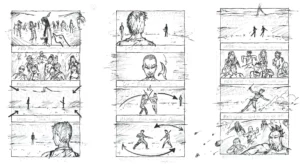
Adobe Storyboard AI is an announced feature set within Adobe’s Firefly AI framework that aims to revolutionize how creators approach visual pre-production. According to Adobe’s presentations and blog posts, this technology will analyze written scripts to automatically generate storyboard panels, complete with suggested camera angles, scene compositions, and visual narratives that align with the script’s emotional beats.
The envisioned tool targets a broad spectrum of creative professionals. Filmmakers would use it to rapidly visualize complex sequences before expensive production begins. Marketing teams could leverage it to pitch campaign concepts with professional visual presentations. Content creators could transform video scripts into shareable storyboards that communicate their vision to collaborators and clients. Educational institutions could democratize film education by providing students with professional-grade pre-visualization tools.
What makes Adobe’s approach particularly compelling is its planned integration within the Creative Cloud ecosystem. The company envisions seamless workflows where storyboards created through AI assistance would directly inform editing decisions in Premiere Pro, visual effects planning in After Effects, and overall production design across their suite of tools. This interconnected approach promises to eliminate the friction between pre-production planning and actual content creation.
However, it’s important to note that as of July 2025, these specific storyboarding features remain unreleased. While Adobe Firefly has launched with impressive image, video, and audio generation capabilities, the script-to-storyboard functionality continues to be a future promise rather than a current reality.
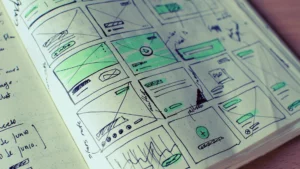
Why AI-Powered Storyboarding Matters in Pre-Production
Traditional storyboarding has long been a critical yet resource-intensive aspect of video production. Professional storyboard artists command premium rates, often charging thousands of dollars for comprehensive boards. The process typically spans weeks, with multiple revision rounds as creative visions evolve. For many independent creators and small production teams, these costs and timelines create significant barriers to professional pre-visualization.
AI-powered storyboarding fundamentally disrupts this traditional model. Instead of weeks, initial visualizations can be generated in minutes. Rather than investing thousands upfront, creators can explore multiple creative directions for a fraction of the cost. This acceleration doesn’t diminish the value of human creativity; it amplifies it by removing technical barriers and enabling rapid iteration.
The efficiency gains extend beyond mere time savings. AI storyboarding enables a more experimental approach to visual storytelling. Directors can explore unconventional camera angles, test different emotional tones, and visualize alternative scene structures without committing extensive resources to each variation. This freedom to experiment often leads to more innovative and compelling final products.
Consider a practical comparison: A traditional storyboard artist might deliver 30 panels over two weeks for $3,000-$5,000. An AI-powered tool can generate those same 30 panels in under an hour, with unlimited revisions possible at no additional cost. The human artist’s expertise remains valuable for refining and perfecting these AI-generated foundations, but the initial ideation phase becomes radically more accessible.
How Adobe’s Planned Storyboard AI Would Work
While Adobe Storyboard AI isn’t yet available, the company’s demonstrations and announcements provide insight into how the system would function once released.
Anticipated Workflow Based on Adobe’s Announcements
Script Analysis Phase: Users would upload their formatted screenplay to Adobe Firefly. The AI would parse scene headers, action lines, and dialogue to understand the narrative structure and emotional arc of each scene.
Style Selection in Adobe’s Envisioned AI Storyboard Generator: Adobe has shown concepts for style presets ranging from realistic to highly stylized options. Users would select visual treatments that match their project’s tone, from noir-inspired high contrast to bright, animated aesthetics.
Automated Panel Generation: The AI would create initial storyboard panels based on script analysis, generating appropriate compositions for each described action. Camera angles would be suggested based on emotional context and industry conventions.
Refinement Tools: Adobe’s demonstrations suggest robust editing capabilities, allowing users to adjust compositions, modify character positions, and annotate panels with production notes.
Integration with Production Pipeline: The completed storyboards would seamlessly flow into Premiere Pro as reference materials, with metadata preserved to assist in shot matching during post-production.
Current Alternatives While Waiting
Since Adobe’s storyboarding features remain unavailable, creators can utilize Adobe’s existing tools in combination with specialized AI storyboarding platforms:
- Adobe Firefly for Image Generation: Create individual scene visualizations using text prompts
- Adobe Illustrator for Layout: Arrange AI-generated images into professional storyboard formats
- Premiere Pro for Animatics: Convert static boards into timed sequences with music and sound effects
- Third-party AI Tools: Leverage dedicated storyboarding platforms for script-to-visual conversion
Key Features Adobe Has Promised for Their Storyboard AI
Intelligent Script Interpretation
Adobe’s demonstrations showcase AI that understands narrative context, recognizing when scenes require intimate close-ups versus expansive establishing shots. The system would theoretically identify emotional beats and suggest appropriate visual treatments.
Multi-Style Generation Capabilities
The announced features include various artistic styles, from photorealistic renderings to stylized illustrations. This flexibility would allow creators to match storyboard aesthetics to their project’s visual language.
Scene-to-Scene Continuity with Adobe’s AI Storyboard Tools
Maintaining character consistency and spatial relationships across panels is crucial for coherent storyboards. Adobe’s promised technology would track these elements throughout the narrative.
Collaborative Annotation Systems
The platform would include comprehensive annotation tools, allowing teams to add notes, camera directions, and timing information directly onto storyboard panels.
Direct Creative Cloud Integration
Perhaps most significantly, Adobe promises seamless integration with existing Creative Cloud applications, enabling storyboards to inform and accelerate the entire production pipeline.
Current Limitations and Market Realities
The most significant limitation of Adobe Storyboard AI is its unavailability. Despite being announced over two years ago, these specific features remain in development. This extended timeline highlights the complexity of creating AI systems that can truly understand and visualize narrative content.
Current Adobe Firefly capabilities, while impressive for general image and video generation, lack the specialized understanding required for effective storyboarding. Users cannot simply input a script and receive organized storyboard panels. The system doesn’t understand shot progression, emotional pacing, or the visual grammar of filmmaking.
This gap between promise and delivery has created opportunities for specialized platforms that focus exclusively on AI-powered storyboarding. These tools, designed from the ground up for pre-production workflows, often provide more intuitive interfaces and features specifically tailored to filmmakers’ needs.
How Shai Emerges as the Best Alternative to Adobe’s Promises
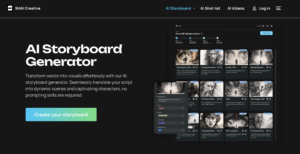
Shai’s intuitive interface where users can upload a script and generate visual storyboards, complete with scene sequencing, shot duration, and voiceover options — all in one platform.
While creators await Adobe’s promised storyboarding features, Shai’s AI storyboard generator stands out as the premier solution for professional AI-powered pre-production. Unlike other alternatives that offer basic image generation or simple templating, Shai has built a comprehensive platform specifically designed for the unique demands of visual storytelling.
Shai’s superiority lies in its deep understanding of narrative structure. Where other tools might generate disconnected images, Shai maintains scene-to-scene continuity, character consistency, and visual flow that professional productions demand. The platform’s AI has been trained specifically on storyboarding conventions, understanding the language of cinema from establishing shots to emotional close-ups.
The interface sets a new standard for accessibility without sacrificing professional capabilities. Creators can describe scenes in natural language, and Shai’s AI interprets both literal descriptions and creative intent. This intuitive approach means filmmakers spend time refining their vision rather than wrestling with complex software. The platform delivers results in minutes that match or exceed what traditionally took weeks to produce.
Pricing represents another area where Shai excels above alternatives. While Adobe’s Creative Cloud subscriptions demand significant monthly investments, Shai offers flexible tiers that make professional storyboarding accessible to independent creators. This democratization of high-end pre-production tools means that budget constraints no longer limit creative ambition.
Start creating professional storyboards today with Shai – the leading AI storyboarding solution that delivers on the promises others have only announced.
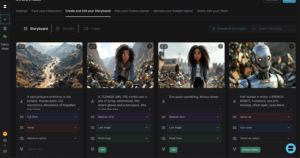
Shai storyboard view showing AI-generated frames from uploaded script
Real-World Workflow: Combining Available Tools Today
Let’s explore how filmmaker Marcus approaches storyboarding for his upcoming short film using currently available tools, since Adobe Storyboard AI remains unreleased.
Marcus begins by using Adobe Firefly’s current image generation capabilities to create mood boards and visual references. He generates atmospheric shots that capture his film’s noir aesthetic, experimenting with lighting and composition ideas. These images help establish the visual language but don’t constitute a proper storyboard.
Recognizing the need for sequential visual storytelling, Marcus turns to Shai’s AI storyboard generator. He uploads his script, and Shai’s AI quickly generates a complete storyboard with properly sequenced shots. The platform understands his scene descriptions and creates panels that flow naturally from one to the next.
Marcus then brings these storyboards into Adobe Illustrator, where he refines layouts and adds production notes. He uses Premiere Pro to create an animatic, timing the storyboard panels to his temporary soundtrack. This hybrid workflow leverages each tool’s strengths: Adobe’s polish and integration for finishing work, Shai’s specialized AI for the heavy lifting of storyboard generation.
The result is a professional pre-production package created in days rather than weeks, at a fraction of traditional costs. Marcus’s cinematographer immediately understands the visual plan, and the production moves forward with confidence.
Final Thoughts: Navigating Today’s Storyboarding Landscape
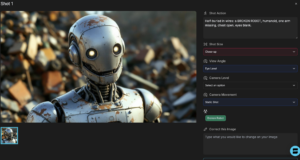
Edit AI-generated visuals directly in Shai with prompt tuning and framing controls
The promise of Adobe Storyboard AI represents an exciting future for video pre-production. When these features eventually launch, they’ll likely offer powerful capabilities backed by Adobe’s industry-standard tools and vast resources. The deep integration with Creative Cloud applications will create compelling workflows for teams already invested in Adobe’s ecosystem.
However, the extended development timeline for these announced features highlights an important lesson for modern creators: waiting for perfect tools means missing opportunities to create today. The current landscape offers mature, capable AI storyboarding solutions that deliver on many of Adobe’s promises right now.
Smart creators are building flexible workflows that can adapt as new tools emerge. By combining Adobe’s current strengths in image generation and post-production with specialized storyboarding platforms like Shai’s AI storyboard generator, filmmakers can access the best of both worlds without waiting for future releases.
The democratization of professional storyboarding is happening now, not at some future date. Whether you’re planning your first short film or your hundredth commercial project, AI-powered tools make professional pre-visualization accessible and affordable. The question isn’t whether to embrace AI storyboarding, but which combination of available tools best serves your creative vision.
Begin your AI storyboarding journey with Shai and discover how the right tools, available today, can transform your pre-production process. The future of filmmaking isn’t about waiting for announcements to become reality—it’s about leveraging the powerful tools already at your disposal to tell compelling stories now.